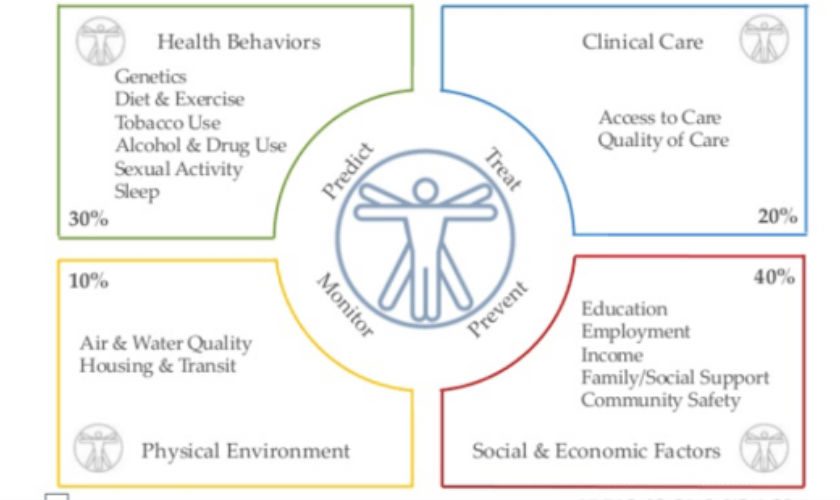
Social Determinants of Health
Western countries are extremely lucky to benefit from both wealth and longevity. This is something that hasn’t happened in previous generations. It is widely believed that healthcare, including public health, has contributed immensely to this increased longevity. However, McKeown, McKinlay et al, Illich and others have questioned the role of medical care within this, and are unwilling to give it full credit. On the other hand, Mackenbach and Bunker believe that medical care has in fact played a fairly significant part in reducing mortality, hence increasing longevity.
So what is helping to ensure longevity, and what must shape the modern day public health system? This discussion can be broken up into four different factors, listed in order of their estimated importance in driving better health and longevity, and as displayed in the attached infographic.
1. Social and Economic factors (40%). Education plays a key role in this category. Low education levels are linked with poor health, more stress and lower self confidence. Poorly educated people are deprived of information and understanding to health services and behaviours that help them prevent and treat disease. Expert-led educational and wellness programmes, early identification and prevention programmes all therefore have a significant part to play in the teaching of this group.
Unemployment and low income is problematic. Lack of money means reduced accessibility of services and treatments. The answer is not necessarily to make healthcare more affordable (that’s a whole other discussion), but to continue with incentive programmes which open up a ‘healthier’ lifestyle. This could be offering subsidised gym memberships, or vouchers for fruit and vegetables, for example. For those on the other side of the coin who are working long hours, better availability of primary care would be of huge benefit, allowing more accessibility to medical help outside of traditional working hours.
Social services can play a bigger role, by having closer contact with disadvantaged community groups. Being more accessible and readily available to help when needed increases the opportunity to treat and prevent disease.
2. Health Behaviours (30%). Modern day lifespans might be longer, but ironically, bad ‘modern’ habits are working against this. Many people eat poor diets, with too much sugar and fat, and not enough fruit and vegetables. Smoking and other drugs are still popular, and exercise receives little attention from many. Eating too much and moving too little is not a good combination. People are also working far longer hours than ever before, often feeling stressed, resulting in little or no sleep.
There is a growing need for better and more extensive health programmes, which educate in relation to diet and exercise, so that people start taking notice, realise the implications and help themselves before the need for medical intervention. Families should be offered further support in changing lifestyles, with self help/support groups. It is so much better to intervene earlier, rather than later, which is not time or cost efficient.
3. Clinical Care (20%). Currently access to medical care is still relatively limited – mostly office hours, few weekends and in fixed places. Opening this up, so that patients can see a Doctor for example, at the weekend, or late in the evening, and at a mobile place based in a more convenient location or even a home visit, would improve patient/ clinician interaction and help catch diagnoses earlier on, hence improving outcomes.
Not only though is access currently an issue, so too is quality of care. Who you see can affect the outcome of your ill health. Some clinicians fail to spot tell tale signs, or do not refer on at the most appropriate next stage. Raising standards and reacting to what the patient would like, are all a must to better healthcare.
4. Physical Environment (10%) plays a key role in health, although surprisingly it is small driver of health outcomes. Safe water and clean air, sufficient food, healthy workplaces, safe houses, communities and roads all contribute to good health. Although air pollution does not have significant effects on overall mortality, it has sometimes been related to higher premature death. Clean water should be a given, but in fact still remains an issue in some countries, as does ensuring individuals have just the basics, such as enough food for the family. Those who are employed tend to be healthier, particularly those who have more control over their working conditions, as they are able to control their physical environment to a greater degree. Better access to safe housing is critical, allowing people have a decent roof over their heads and are able to stay warm and dry.
Targeted monitoring is key – to obtain the ability to define who needs what help in the community and when it is required, with a rapid response to resolve the issue. Community based health initiatives are critical to educate and incentivise what’s been learnt, with continuous monitoring from health professionals. If interventions can be as targeted and controlled in this manner, with local communities serving as self help groups, the reduction in medical intervention would be dramatic.
To conclude, it is justified to say that non-medical inputs are more important than medical inputs in determining health outcomes. A focus on health promotion strategies will see the way to continuing the privilege of a longer, healthier life. Technology allows us provide cost-effective, continuous, real-time monitoring for everyone. Combining the two will support a shift from the inefficient reactive treatment of disease, to the efficientproactive maintenance of health.
Further reading:
http://www.ncbi.nlm.nih.gov/pubmed/16076396
http://bmcpublichealth.biomedcentral.com/articles/10.1186/1471-2458-5-81



